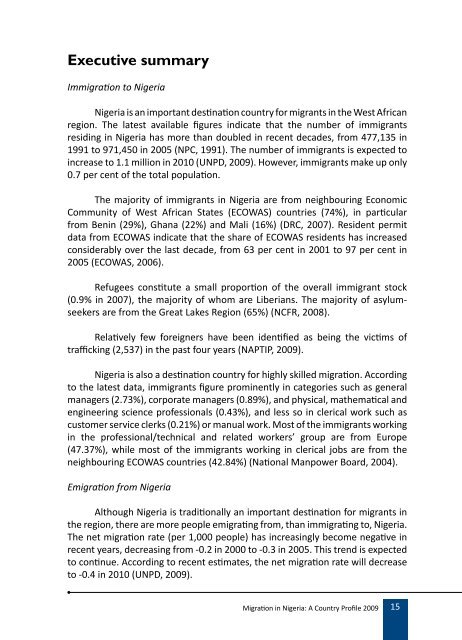Migration Profile on Nigeria - IOM Publications - International ...
Migration Profile on Nigeria - IOM Publications - International ...
Migration Profile on Nigeria - IOM Publications - International ...
Create successful ePaper yourself
Turn your PDF publications into a flip-book with our unique Google optimized e-Paper software.
executive summary<br />
Immigrati<strong>on</strong> to <strong>Nigeria</strong><br />
<strong>Nigeria</strong> is an important destinati<strong>on</strong> country for migrants in the West African<br />
regi<strong>on</strong>. The latest available figures indicate that the number of immigrants<br />
residing in <strong>Nigeria</strong> has more than doubled in recent decades, from 477,135 in<br />
1991 to 971,450 in 2005 (NPC, 1991). The number of immigrants is expected to<br />
increase to 1.1 milli<strong>on</strong> in 2010 (UNPD, 2009). However, immigrants make up <strong>on</strong>ly<br />
0.7 per cent of the total populati<strong>on</strong>.<br />
The majority of immigrants in <strong>Nigeria</strong> are from neighbouring Ec<strong>on</strong>omic<br />
Community of West African States (ECOWAS) countries (74%), in particular<br />
from Benin (29%), Ghana (22%) and Mali (16%) (DRC, 2007). Resident permit<br />
data from ECOWAS indicate that the share of ECOWAS residents has increased<br />
c<strong>on</strong>siderably over the last decade, from 63 per cent in 2001 to 97 per cent in<br />
2005 (ECOWAS, 2006).<br />
Refugees c<strong>on</strong>stitute a small proporti<strong>on</strong> of the overall immigrant stock<br />
(0.9% in 2007), the majority of whom are Liberians. The majority of asylumseekers<br />
are from the Great Lakes Regi<strong>on</strong> (65%) (NCFR, 2008).<br />
Relatively few foreigners have been identified as being the victims of<br />
trafficking (2,537) in the past four years (NAPTIP, 2009).<br />
<strong>Nigeria</strong> is also a destinati<strong>on</strong> country for highly skilled migrati<strong>on</strong>. According<br />
to the latest data, immigrants figure prominently in categories such as general<br />
managers (2.73%), corporate managers (0.89%), and physical, mathematical and<br />
engineering science professi<strong>on</strong>als (0.43%), and less so in clerical work such as<br />
customer service clerks (0.21%) or manual work. Most of the immigrants working<br />
in the professi<strong>on</strong>al/technical and related workers’ group are from Europe<br />
(47.37%), while most of the immigrants working in clerical jobs are from the<br />
neighbouring ECOWAS countries (42.84%) (Nati<strong>on</strong>al Manpower Board, 2004).<br />
Emigrati<strong>on</strong> from <strong>Nigeria</strong><br />
Although <strong>Nigeria</strong> is traditi<strong>on</strong>ally an important destinati<strong>on</strong> for migrants in<br />
the regi<strong>on</strong>, there are more people emigrating from, than immigrating to, <strong>Nigeria</strong>.<br />
The net migrati<strong>on</strong> rate (per 1,000 people) has increasingly become negative in<br />
recent years, decreasing from -0.2 in 2000 to -0.3 in 2005. This trend is expected<br />
to c<strong>on</strong>tinue. According to recent estimates, the net migrati<strong>on</strong> rate will decrease<br />
to -0.4 in 2010 (UNPD, 2009).<br />
<str<strong>on</strong>g>Migrati<strong>on</strong></str<strong>on</strong>g> in <strong>Nigeria</strong>: A Country <str<strong>on</strong>g>Profile</str<strong>on</strong>g> 2009<br />
15

















